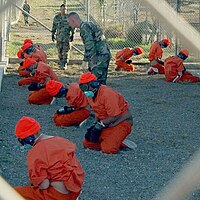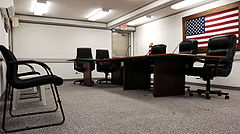Saudi most-wanted list includes former Guantanamo captives
Monday, February 9, 2009

Image: Shane T. McCoy, U.S. Navy.
On February 3, 2009, the Government of Saudi Arabia released a list of 85 most wanted suspected terrorists. In the days that followed, close to a dozen former Guantanamo captives were identified, among those were 85 men and boys.
Guantanamo has held 129 Saudi captives. 113 of the Saudi captives have been set free or transferred to Saudi custody. Most former captives were held, for a time, at the Care rehabilitation center. The center is described as a humane facility. The intent of the center was to re-educate and re-integrate into mainstream Saudi society. It employed counseling, lectures, and generous financial assistance upon graduation.
The program was described as successful. It was held up as a model, and the United States encouraged neighboring countries, like Yemen, to set up similar rehabilitation and reintegration programs.
Then in January 2009, two former Guantanamo captives, and alumni of the rehabilitation program, Sa'id Ali Jabir Al Khathim Al Shihri (ISN 372) and Abu Hareth Muhammad al-Oufi (ISN 333) appeared in a threatening Al Qaeda video. Said Jabir identified himself as the second in command of Al-Qaida in the Arabian Peninsula. Up until this video became public the Saudi government had claimed the program was a complete success.
The two men were among the men listed on the most wanted list. It has been reported that eleven former captives are on the list. The Saudi government hasn't officially identified the former Guantanamo captives in any English language press release; however, reporters and researchers have identified eight former Guantanamo captive on the list, in the English media.
In addition to Abu Hareth Muhammad al-Oufi and Sa'id Ali Jabir Al Khathim Al Shihri the other six former captives identified in English language media are: Adnan Al-Sayegh (ISN 105), Yusuf Al Jebairi Al Shahri (ISN 114), Othman Al-Ghamdi (ISN 184), Turki Mashawi Al Aseery (ISN 185), Murtadi Muqrim (ISN 187), Jaber Jabran (ISN 188).

Image: Navy Petty Officer 2nd Class Michael Billings or Army Sgt. Sarah Stannard.
The transfer of Abu Hareth Muhammad al-Oufi and Sa'id Ali Jabir Al Khathim Al Shihri is widely used as an example of the difficulties in distinguishing which captives no longer posed a threat, and could safely be sent home. All the review boards of these men had recommended that they continued to pose a sufficiently serious threat to the U.S. and that they should remain in U.S. custody.
Six of the eight former Guantanamo captives who ended up on the Saudi's most wanted list following their release from Saudi custody were transferred in spite of all their annual review boards recommending their continued detention.
Of the 300 former captives transferred from Guantanamo since authorities started conducting formal reviews in 2004 three quarters were transferred after officers sitting on a board or tribunal had recommended their transfer. Of these eight men only Adnan Al-Sayegh and Jabir Jabran were sent home because their annual review had recommended their release. Adnan Al-Sayegh's repatriation to Saudi custody was authorized on August 16, 2005, and he was repatriated on May 19, 2006. Jabir Jabran's repatriation was authorized on June 26, 2006, and he was repatriated on February 21, 2007.
The other six men, those not recommended for transfer, were all transferred on November 9, 2007. These six were among thirteen Saudis repatriated that day. Eleven of which were repatriated in spite of the recommendations of their review boards.
Sources
- Mansour Al-Shihri and Khaled A-Shalahi. "Names keep climbing on infamous terror list" — Saudi Gazette, February 8, 2009
- Donna Abu-Nasr. "Saudi suspects seeking to revive al-Qaida" — Associated Press, February 7, 2009
- Mshari Al-Zaydi. "A Clear Generation Gap in Saudi Most Wanted List" — Asharq Alawsat, February 6, 2009
- Turki Al-Saheil. "Al-Qaeda Using Iran as Base of Operations" — Asharq Alawsat, February 5, 2009
- Paul Schemm. "11 former Gitmo inmates on Saudi wanted list" — Associated Press, February 4, 2009
- Robert Worth. "Saudis Issue List of 85 Terrorism Suspects" — New York Times, February 3, 2009
- Carol Rosenberg. "Saudi 'most wanted list' includes freed detainees" — Miami Herald, February 2, 2009
- Nancy Durham. "Attempting to rehabilitate Riyadh's jihadists" — CBC News, January 28, 2009
- Bobby Ghosh. "Can Jihadis Be Rehabilitated?" — Time magazine, January 27, 2009
- Andrew O. Selsky. "U.S. Defends Transfers as Ex-Detainees Vow Terror" — Washington Post, January 27, 2009
- "Two ex-Guantanamo inmates appear in Al-Qaeda video" — Agence France Presse, January 25, 2009
- OARDEC. "Consolidated chronological listing of GTMO detainees released, transferred or deceased" — Department of Defense, November 25, 2008
- Nancy Durham. "Can therapy 'cure' terrorism?" — CBC News, January 14, 2008